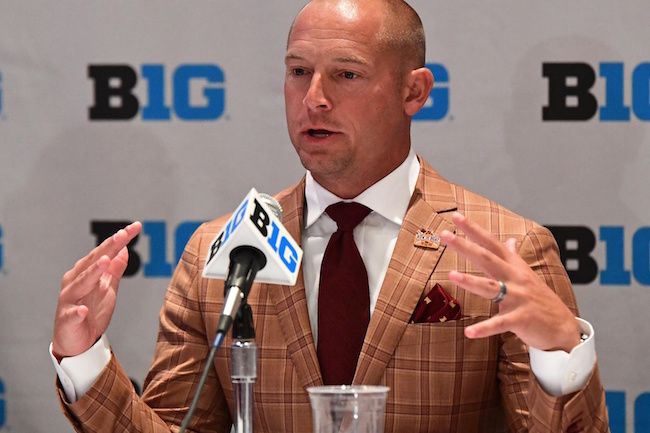Ad Disclosure
When P.J. Fleck took the job at Minnesota, it seemed inevitable that he would try and do things differently.
He knew he was different than the traditional, low-profile coaches that lined the B1G West. He didn’t seem like the type of guy who would do something because “that’s the way it’s always been.”
We got a solid reminder of that on Monday. That’s when the Gophers announced that they would have six (!) fall practices that were open to the media and the public.
That’s right. The public. In the fall.
This is what Minnesota’s fall camp availability looks like until Aug. 17:
Minnesota Football Preseason Camp Dates Open To The Media And Public
Aug. 4, 6:00 p.m. – Gibson-Nagurski Football Complex
Aug. 5, 3:30 p.m. – Gibson-Nagurski Football Complex
Aug. 8, 3:30 p.m. – Gibson-Nagurski Football Complex
Aug. 11, 4:15 p.m. – Gibson-Nagurski Football Complex
Aug. 15, 3:30 p.m. – Gibson-Nagurski Football Complex
Aug. 17, 3:30 p.m. – Gibson-Nagurski Football Complex
Fleck isn’t just having one “student appreciation day” or one day a week that media members can show up and watch practice for a half hour.
He isn’t withholding access for multiple weeks like Ed Orgeron did at LSU this year or like Jim Harbaugh did at Michigan in his first season. Both coaches explained the need for limited distractions while they implemented new offenses. After all, fall ain’t spring. There are actual games to prepare for.
But Fleck went in an opposite direction. He isn’t necessarily wrong for doing that, either.
On the surface, it might not make much sense to have open practices. These days, if teams can avoid leaking possible important information, they’re gonna do it. The stakes are too high to let someone with a smart phone snap a photo of a secret formation they had been working on for weeks.
Or teams can just allow access for the vanilla parts of practice, which is likely what Fleck will do.
Will it distract his team from getting ready for the season opener against Buffalo on Aug. 31? Well if that happens, they’ll still have a whole two weeks after those open practices to “refocus.”
Fleck is doing this for one reason and one reason only. He has a program to sell.
Minnesota isn’t Michigan or LSU. The Gophers won’t sell out TCF Bank Stadium if they simply operate the status quo. They won’t be the talk of national college football pundits, at least they won’t without Fleck’s marketing. He’s still trying to build the Gopher brand, which is in need of restructuring despite the fact that the team won eight-plus games in three of the last four seasons.
He wants fan support at an all-time high. When recruits show up for official visits for games in mid-November, he doesn’t want them sitting in a 30-degree stadium with 10,000 empty seats.
Does allowing public access to a half-dozen practices guarantee he’ll sell out every game? No, but he certainly won’t lose fan support by opening Minnesota’s doors earlier and more often than usual.
It’s the same reason Fleck allowed an ESPN documentary crew to follow his transition to Minnesota. He wants new eyes on his program in whatever clean way he can get them. If that means sending out more scholarship offers than the rest of the B1G West combined, so be it. It’s his job to change the national perception of Minnesota, one person at a time.
Had an ELITE time delivering season tickets last week!! Excited to see TCF Bank Stadium packed a month from today!! https://t.co/hjVVRt905M
— P.J. Fleck (@Coach_Fleck) July 31, 2017
Fleck’s access is going to be different than what we’re used to, at least in the short term. He’s also aware of how important the media is in shaping a coach’s image. Making reporters’ jobs more difficult before he ever coaches a game isn’t something he wants to do, either.
Coverage is a good thing, especially as the Vikings are ramping things up and the Twins are (potentially) playing meaningful baseball down the road. He wants his team in the news, and not for off-the-field issues. Lord knows banning media access gives reporters all the time in the world to dig into non-football matters.
Instead, Fleck will do something unconventional. Not everyone on the outside will agree with allowing that kind of access. That doesn’t matter to him. What does matter is that he uses every opportunity possible to generate excitement for his program.
There’s nothing wrong with that.
Connor O'Gara is the senior national columnist for Saturday Tradition. He's a member of the Football Writers Association of America. After spending his entire life living in B1G country, he moved to the South in 2015.
